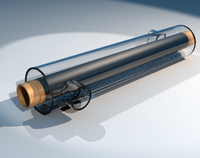
Photo from wikipedia
Abstract In a simple model to predict heat pipe performance, uniform thermal loads are assumed over heat transfer surfaces. The validity of the simple model is limited in many application… Click to show full abstract
Abstract In a simple model to predict heat pipe performance, uniform thermal loads are assumed over heat transfer surfaces. The validity of the simple model is limited in many application areas such as electronics cooling and space thermal control, where a heat pipe is often subject to multiple, unequal thermal loads. This study aims to experimentally identify the performance of a cylindrical heat pipe under various multiple heat source configurations and thus to quantitatively estimate the deviation from a heat pipe under uniform conditions. The model heat pipe was 9.53 mm in diameter and 0.6 m in length, with a 0.4 m evaporator. The working fluid and the container wall were water and copper, respectively, and a wire mesh screen was inserted as a capillary structure. The fluid charge ratios tested were 100% and 120% based on the wick void volume. The heat pipe was in gravity-assisted mode with an inclination angle of 45° to extend the range of thermal input. Five small heaters were installed in the evaporator with equal spacing, and the power inputs were controlled individually. Three different thermal load configurations were imposed: equal, increasing and decreasing distributions toward the condenser. The results were compared from the viewpoints of thermal resistance and effective thermal conductance. The thermal resistance of the heat pipe with a 100% fluid charge exhibited excellent values from 0.16 K/W (at 50 W) to 0.03 K/W (at 300 W) for a uniform heat load. However, those with multiple thermal loads resulted in almost a 100% increase for the lower thermal load, and up to a 40% increase for the higher thermal loads, depending on the configuration. The behavior of the heat pipe with a fluid charge of 120% exhibited little difference. The results herein can be employed to estimate the performance deviation of a heat pipe due to thermal load distribution.
Journal Title: Applied Thermal Engineering
Year Published: 2017
Link to full text (if available)
Share on Social Media: Sign Up to like & get
recommendations!